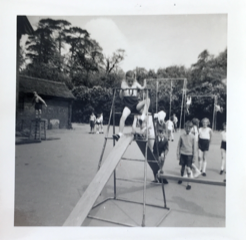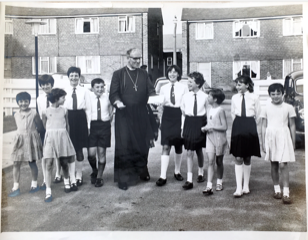Westwood School
- westwoodheathra
- Jul 1, 2019
- 3 min read
Updated: Dec 2, 2019
Today's "Memory Monday" is all about Westwood School.
The Westwood School (now the Greek Orthodox Church) was built by the Leigh family in 1870, with additional funding from The National Society (a Church of England organisation). It replaced an old school room, which was converted into the library and reading rooms, on the site of the current Westwood Club. It fell to the school headmaster to take responsibility for reading newspapers to the farm workers in the Reading Rooms.
The new school went from strength to strength until by the 1950s and 60s it had an excellent reputation for grammar school passes amongst its pupils and just under 100 pupils in attendance, led by Mr Harry Hancock as headmaster (1953-66). This was a remarkable number given the limited space within the building.
In the 1950s, the infant classroom was at the front of the school. All the children had lunch there. The Juniors were located at the back, the 2 areas being separated by a partition. There was a small kitchen, but meals were not cooked in there; they were brought in aluminium containers, possibly from the Templars School. Toilet facilities were basic but adequate – Elson chemical toilets emptied every evening by the caretaker.
There was a school uniform of green and white gingham dresses for the girls and grey shorts with a green jumper for the boys. The children loved the school pet rabbit, cared for in the holidays by the caretaker.
The playground was to the side and rear of the school, with the Headmaster’s house adjacent. This was occupied by a previous headmaster, Mr L Wright, known as “Daddy” Wright, who carried on living there after his retirement in 1947. Mr Wright remained there – and continued his reading room duties – until his death. Mr Hancock and his family lived on Westwood Heath Road.
Most of the children in the 1950s and 60s walked to school and were from farming families. Mr Hancock ran an intermediate class in his study, as well as an extra class for grammar school exam entrants twice weekly. He also encouraged the children to be physically active. There was gym equipment in the playground and the children also took part in marching and country dancing. An accomplished clarinettist himself, Mr Hancock was keen for the children to learn musical skills; he was not a fan of the ubiquitous recorder, so they learned the melodica instead!
The children enjoyed school trips including to Llandudno and to the Royal Tournament at Earls Court. The annual vicarage fete and maypole dancing were also highlights of the school year.
By the 1960s the school was in need of modernisation but it was considered more prudent to move. It was fortunate given the links with the church that the site of the old vicarage, off Torrington Avenue, became available following a re-organisation of the parish in the early 1960s. So it was that a brand new school – the Leigh School – was opened on 12thJuly 1967, with Mr Hancock as its first headmaster. The Leigh family continued to maintain contact with the school in its new incarnation, including Lord Leigh attending on Speech Day to present prizes.
The old school at Westwood Heath lay unused for several years until the Greek Orthodox community in Coventry, looking for a spiritual home, saw its potential. They purchased it in 1974 and established the Greek Orthodox Church of the Holy Transfiguration.
Sources:
Many thanks to Peter Hancock for sharing his recollections.
Leigh Church of England School Opening & Dedication booklet, 1967.
"The City of Coventry: Public education." A History of the County of Warwick: Volume 8, the City of Coventry and Borough of Warwick. Ed. W B Stephens. London: Victoria County History, 1969. 299-315. British History Online. Web. 29 June 2019. http://www.british-history.ac.uk/vch/warks/vol8/pp299-315.
Images:
Reproduced with kind permission of Peter Hancock:
Westwood School, 1960s
Vicarage Garden Fete, 1956
Lord Leigh at Speech Day
School sign showing the Leigh crest and the school motto
Gym equipment in the playground
Playground
Opening of Leigh School, children with the Bishop of Coventry















Comments